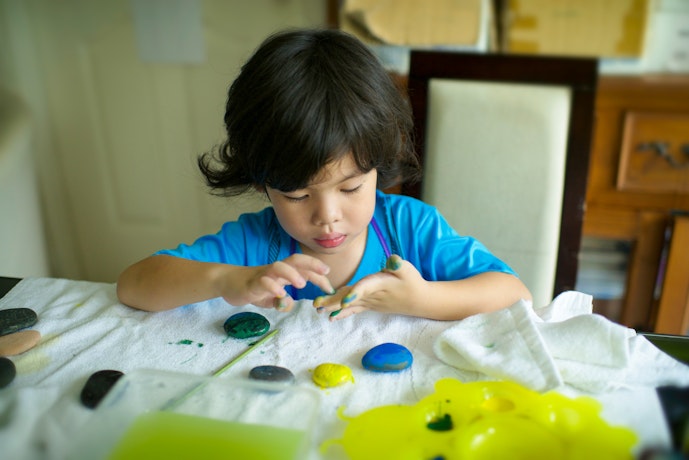During my college years, while pursuing my Interdisciplinary Early Childhood Education degree, I received an assignment that involved guiding a preschool-age child in crafting a story. I vividly recall assisting my niece, attempting to make her scribbles appear more coherent, as I mistakenly believed they needed to be "put together." Looking back, I regret intervening in her imaginative process. However, my professor had a purpose – she aimed to show her college students the significance of not interfering with a child's creativity.
Letting Go of Control
As adults, when we take control of such experiences, we inadvertently rob children of valuable opportunities. We hinder the development of their cognitive and fine-motor skills, stifle their imaginative capacities, and impede their ability to express themselves. Fast forward several years, and that once-preschooler is now 16, and one of the most artistically inclined individuals I know.
The lesson learned from that assignment played a pivotal role in my journey as both a teacher and a mother. Throughout my teaching career, the art station in my classroom was consistently one of the most popular areas among students. It boasted an array of art supplies, including paper, pencils, markers, paint, collage materials like stickers and gems, playdough, clay, and much more.
One of the most gratifying aspects of teaching was witnessing the unique creations children would produce and hearing them describe their masterpieces. To the casual observer, it might appear as mere scribbles, but to the child, it represented a majestic ocean filled with mermaids, an exhilarating amusement park with the coolest rollercoaster, or a winter wonderland adorned with enchanting snowmen.
Open-Ended Art
Our world is dominated by screens and structured activities, so fostering a child's imagination and creativity has never been more crucial. One avenue that holds immense potential for unleashing a child's artistic flair is through open-ended arts and crafts.
Open-ended art refers to activities that have no predetermined outcome, allowing children to explore their creativity freely. It focuses more on the process rather than the product. This unstructured form of expression not only provides a break from the rigidity of daily routines but also nurtures essential skills in a child's development.
One key advantage of open-ended art is the stimulation of imagination. When children are given the freedom to choose their materials, colors, and themes, they engage in a process that encourages independent thinking. This kind of creative exploration fosters problem-solving skills as children learn to make decisions and adapt their ideas along the way.
Moreover, open-ended art allows children to develop a sense of ownership and pride in their creations. There is no right or wrong way to express oneself in this context, fostering a positive self-image and boosting self-esteem. The absence of rigid guidelines enables kids to embrace their uniqueness, reinforcing the idea that every creation is special and valued.
The tactile nature of arts and crafts activities also contributes to the holistic development of a child. From fine motor skills to hand-eye coordination, the physical act of cutting, gluing, and painting enhances a range of motor abilities crucial for a child's overall growth.
Expression Through Arts
Additionally, open-ended art fosters emotional expression. Children can use art as a medium to convey feelings, thoughts, and experiences that might be challenging to articulate verbally. This emotional outlet not only aids in developing emotional intelligence but also provides a healthy means of coping with stress or uncertainties.
Art offers a safe and non-judgmental space where youngsters can experiment with different materials and techniques, allowing them to discover their preferred modes of expression. Whether it's a whimsical drawing, a colorful collage, or a handcrafted masterpiece, each creation becomes a unique reflection of a child's inner world, allowing them to communicate their feelings, experiences, and imaginative visions.
The process of engaging in arts and crafts also facilitates the development of essential life skills as children learn to navigate the creative process. From conceptualizing an idea to selecting materials, making decisions about design, and persevering through challenges, the entire artistic journey becomes a microcosm of real-life decision-making. As children experiment with various artistic elements, they not only hone their fine motor skills but also cultivate problem-solving abilities and develop a sense of responsibility for their work, not to mention the amount of laughter and joy art and play bring to a child’s life. In this way, arts and crafts become a holistic avenue for self-expression and skill-building, contributing significantly to a child's emotional, cognitive, and social development.
Shift Your Perspective
For adults, especially those of us who prefer a well-organized and cohesive living space, it can be challenging to let go of control and permit children to express their creativity freely. There are moments when we may wince at artwork displayed on the refrigerator because the colors clash with our decor, or the elephant our child drew seems more like a formless blob. Yet, it is essential to shift our perspective and recognize the valuable skills our child is acquiring.
The true beauty of allowing children to explore their creativity unhindered lies in the diverse array of emerging benefits. By releasing control and offering them the freedom to express themselves, we foster the development of vital cognitive and fine motor skills, along with embracing art for emotional regulation. In doing so, we bear witness to the extraordinary landscapes and narratives that unfold from the depths of their imaginative minds.














